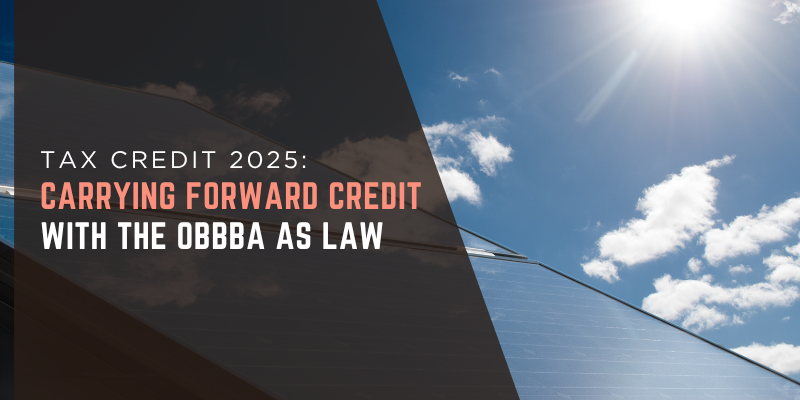Can I Carry Forward Unused Solar Tax Credit with the One Big Beautiful Bill as Law?
The solar.com editorial team monitors solar forums and communities to better inform what questions are being asked so we can create relevant content. (Huge shout out to the r/solar community on Reddit. If you’re thinking of going solar definitely check out r/solar – there’s a ton of great advice and helpful posters there).
Here’s one subject that’s repeatedly being asked about, and that someone emailed us directly about: With the consumer solar tax credit, claimed under Section 25D, going away at the end of 2025, what happens to the Carry Forward Provision? If I don’t have sufficient tax liability to claim the full credit on my 2025 taxes, can I still rollover unused credit to 2026 and beyond?
Jump ahead:
- Understanding the Solar Tax Credit Carry Forward Provision
- How does carrying forward the solar tax credit work?
- But with the Tax Credit Expiring, Does the Carry Forward Remain?
With the usual caveat of this not being tax advice and to consult your accountant about your specific situation, let’s dive into the topic.
Understanding the Solar Tax Credit Carry Forward Provision
The carry forward provision for the 25D Residential Clean Energy Credit allows homeowners with insufficient tax liabilities to “carry forward” their tax credit to future tax years, where they may be able to use the leftover credit amount. As a non-refundable credit, the solar tax credit can only be used to reduce your tax liability, and the IRS does not send you a check back if your “credits” exceed your liabilities.
In some scenarios, homeowners have the financial means to go solar, but through tax efficiency, their tax credit exceeds their tax liability. With the carry forward provision, they’re able to spread out that tax credit over multiple years to monetize it.
How does carrying forward the solar tax credit work?
As an example, meet Mr. and Mrs. Panel. The Panel family had a busy 2025. Mrs. Panel gave birth to Baby Panel in February and she made the decision to take a year off work to spend time at home. They also realized, thanks to Baby Panel, that they’d outgrown their life in the city and decided to buy a house. To finance this purchase, they sold some of their investments at a loss. Mr Panel kept working, making $100,000/year at his job as an importer/exporter at Vandelay Industries.
With the ending of the tax credit, the Panels decided to go solar in 2025 (through solar.com which helped them vet local installers and created customized proposals for them). The Panels installed a 10kW system at $3/watt which generates a $9,000 tax credit, but their federal tax liability was only $1,000 after accounting for the child tax deduction, the tax loss harvesting, and the various deductions for purchasing their home.
Thanks to the carry forward provision, the Panels can offset their remaining $1,000 tax liability for 2025 and next year, in 2026, when things “normalize” and Mrs Panel goes back to work, they can monetize the remaining $8,000 credit.
But with the Tax Credit Expiring, Does the Carry Forward Remain?
The IRS generally considers the project qualified for the rules of the tax year in which it becomes eligible for the tax credit. Because the Panels had their project mechanically complete in 2025, this means the 2025 rules apply, and they can carry forward their unused tax credit—even with the “One Big Beautiful Bill” terminating this tax credit at the end of 2025.
In January 2025, the IRS released a Fact Sheet regarding home energy credits, including the Section 25D Clean Energy Property Credit (which we know as the solar tax credit). Page 15 of this Fact Sheet confirms that carrying forward unused tax credit is currently allowed:

Notably, the IRS does not give an expiration date for carrying forward credit. But, again, there are nuances to these rules and the IRS may change its guidance later in 2025. For instance, the 25D tax credit is claimed on Form 5695, which typically includes lines specifically for carrying forward unused credit. However, with the 25D credit ending, this form may not be available in future tax years and it may require different forms and processes to claim unused credit.
As such, homeowners should always seek professional counsel based on their specific circumstances from a certified professional.
We’d also like to point out that while there are absolutely scenarios where homeowners can have near term low tax liabilities (like our fictional friends the Panels) a better option for homeowners with persistently low tax liabilities would be to enter into a PPA or lease arrangement where a company monetizes the tax credit and offers a savings from the utility rate, while taking on the obligation of maintaining the system.
Have a question for the solar.com editorial team that you’d like us to address? Email us at newsroom@solar.com






